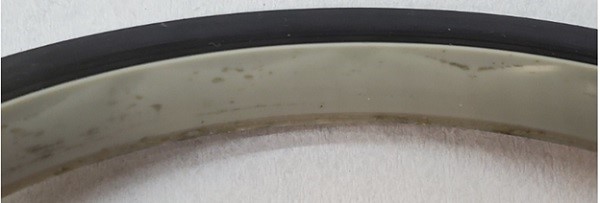Plastic Lined Kalsi Seals™ have the most pressure capacity of any polymeric rotary shaft seal. This video explains why.
We are pleased to announce a new video (above) that describes a 368-hour 10,000 psi test of a washpipe assembly with a 3-inch bore and a 4.50-inch sealing diameter. The test was conducted at 120 rpm for 165-hours, 150 rpm for 165-hours, and 175 rpm for 38-hours. The rotary seals were still in good condition when the test was shut down for seal inspection after 368-hours of 10,000 psi operation.
The pressurized test fluid was non-circulating anti-freeze that was pressurized with a piston pump. A modest amount of cooling was provided by circulating low pressure water through a stationary U-shaped tube that was located inside the rotating washpipe. The water circulation rate was about 8 gpm. The temperature of the pressurized fluid near the high-pressure seal was approximately 103°F at 120 rpm, 110°F at 150 rpm, and 115°F at 175 rpm. Such low temperatures were possible because of the low friction characteristics of the rotary seals.
The washpipe assembly uses two rotary seals. The region between the rotary seals is filled with seal lubricant. The pressure of the seal lubricant is balanced to the pressure of the pressurized test fluid by an annular piston.
The upper rotary seal is a KLS-brand spring-loaded lip seal that partitions the seal lubricant from the pressurized test fluid. The KLS® Seal is mounted in a floating seal carrier that has a journal bearing relationship with the rotating washpipe. The seal carrier moves laterally to follow washpipe runout, minimizing the runout-related compression changes experienced by the KLS Seal.
The lower rotary seal is a is a Super Wide Plastic Lined Kalsi Seal™ that retains the high-pressure lubricant. This seal features a pressure-resistant plastic liner and our patented hydrodynamic waves. These highly engineered waves pump a thin film of lubricant into the dynamic sealing interface during rotation of the washpipe. This reduces friction, wear, and seal-generated heat. The reduced operating temperature promotes high pressure extrusion resistance by reducing the temperature related loss of seal modulus.
The lower rotary seal is mounted in our patented floating metal backup ring. The backup ring has a journal bearing relationship with the washpipe that causes the ring to follow the runout of the washpipe. The journal bearing defines a very small extrusion gap clearance with respect to the washpipe, which maximizes the high-pressure performance of the lower rotary seal. The combination of the Super Wide Plastic Lined Seal™ and the floating backup ring provided the pressure capacity to successfully handle 10,000 psi at 120 to 175 rpm with a 4.50-inch seal.
Contact our staff to learn more about using Kalsi Seals in your extreme pressure equipment.


